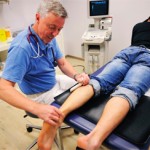Researchers have identified a unique population of entheseal resident cells that can be activated by interleukin 23 (IL-23).1 When activated, the T cells produce IL-22 and activate signal transducer and activator of transcription 3 (STAT3)–dependent osteoblast-mediated bone remodeling. This finding may be key to understanding how dysregulation of IL-23 results in precise inflammation of the entheses. Up until now, the entheses has not been considered to be a site of resident immune surveillance.
Inflammation in the enthesis causes the painful symptoms of spondylarthritic disease. Spondylarthropies such as ankylosing spondylitis (AS) have also consistently been accompanied by an association with the human leukocyte antigen B27 (HLA-B27) and elevated levels of serum IL-23. Beyond this, the pathogenesis of AS and other spondylarthropies has been poorly understood, to the extent that there is a great deal of debate as to whether AS is a true antigen-specific autoimmune disease or an autoinflammatory condition.
Investigators have long been puzzled by the exact cause of the immune response in patients with AS. Recent findings have pointed to IL-23 as a key factor in spondylarthropathy, and therefore investigators used an experimental mouse model of systemic IL-23 overexpression to explore the issue further. Results from the current study have led the investigators to suggest that, in fact, dysregulated IL-23 biology is the fundamental to spondylarthropathy.
The IL-23 receptor (IL23-R) has previously been shown to control the expansion and elaboration of IL-17 during infection in wild-type mice. Sherlock and colleagues identified a population of CD3+CD4–CD8-IL–23R+, RAR-related orphan receptor γt (ROR-γt)+ T cells in the enthesis of mice. These cells appear to be primed to rapidly react to IL-23, resulting in the inflammation that is characteristic of spondylarthropathy.
Daniel J. Cua, PhD, of Merck Research Laboratories in Pal Alto, Calif., the corresponding investigator of the study, explained via email, “It was very surprising to us that the enthesis … harbor a population of specific, highly potent immune cells. Until now, the dogma was that entheses are ‘acellular’ fibrous tissues. Indeed, we were only able to detect these unique cells using new technologies such as the IL-23R-eGFP reporter mice and high-resolution multiphoton microscopy. These immune cells are CD3+ T cells, but they do not have CD4 or CD8 and therefore don’t recognize antigen efficiently. Instead, they may be directly activated by stress signals and function like ‘innate immune cells’ that can directly respond to stress and injury.”
Imagine the implications. The investigators are describing how systemic cytokine expression could be initiated in one place in the body and have a tissue-specific pathology elsewhere in the body.
In an accompanying “News and Views” article, Rik J. Lories, MD, PhD, of KU Leuven in Belgium and Iain B. McInnes, PhD, at the University of Glasgow in the United Kingdom, wrote: “There have been a limited number of clinical trials targeting the IL-23–IL-17 axis in spondylarthritis, and such approaches have shown modest clinical benefits; these trials have focused mainly on strategies that neutralize IL-17. The data of Sherlock et al suggest that IL-23 mediates broader effects, operating beyond IL-17, and therefore the therapeutic utility of agents that block IL-23 or its receptor may be worthy of early exploration.”2
Spondylarthritis affects 2.4 million people in the United States and has a prevalence of 1% to 2% worldwide.
Dr. Pullen is a medical writer based in the Chicago area.
References
